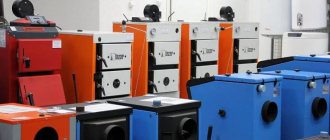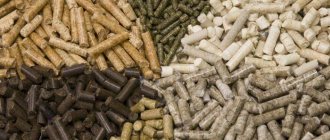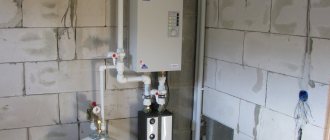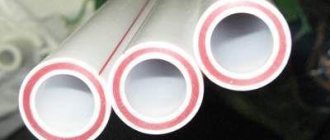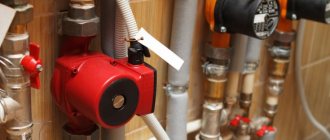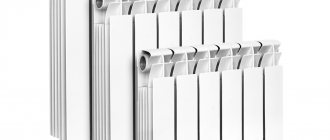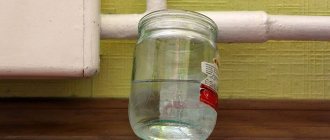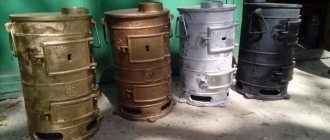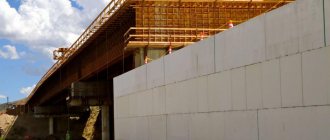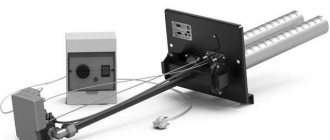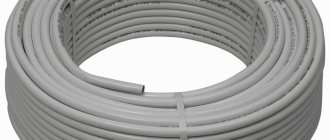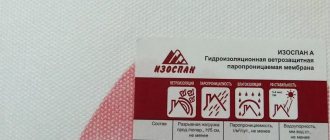It seems to many that corrugated pipes are a relatively recent product on the plumbing market. In fact, corrugated pipes have long been firmly established in every home as a shower hose. Corrugated stainless steel pipes for heating came into use a decade ago, successfully replacing smooth-walled counterparts in modern engineering systems. Let's figure out what benefits the use of corrugation brings, what it comes in, and why its installation is considered simple.
Connecting a radiator through a corrugated pipe Source metallobaza-sm.ru
Varieties
The industry produces two types of corrugated stainless steel pipes, differing in the method of technological processing:
- Annealed. After additional heat treatment, the metal becomes softer and more ductile (however, such products are one and a half times more expensive than conventional analogues). If the system is designed with turns, the pipe will successfully withstand the kinks and remain intact.
- Unannealed. Externally, they cannot be distinguished from products that have undergone additional heat treatment. They hold their shape well and practically do not sag between the support points, maintaining a horizontal state (if the areas are not too long). It is better to avoid them if the system is complex and has many turns, since deformations will form at the bends.
The main characteristic of flexible heating pipes, rigidity, depends not only on the heat treatment, but also on the wall thickness (more precisely, on the thickness of the sheet from which the corrugation is made). The thickness varies between 0.13-0.5 mm. The higher the parameter, the worse the corrugated spiral bends. There is an advantage to this: the stiffer the product, the better it retains its shape.
Fragment of corrugation with fitting Source laminatepol.ru
Performance characteristics
Stainless steel corrugation is considered a convenient and inexpensive substitute for classic heating pipelines (especially when compared with copper ones). The practicality is obvious: in terms of performance characteristics, stainless steel is not inferior to copper, but in terms of finance it is many times more attractive. The use of high-quality metal corrugations allows you to obtain a reliable system while maintaining its reasonable cost.
Standard corrugation in the mid-price segment (for household systems) has the following characteristics:
- Diameter: 15, 20, 25, 32 mm. Large diameters (up to 100 mm and above) are rarely used. There is a concept of external and internal diameter. For example, a product stated to have a diameter of 12 mm has an outer diameter of 16.2 mm and an inner diameter of 11.8 mm.
- Wall thickness: 0.25-0.3 mm.
- Working pressure – 15 bar (atmospheres). An excess of up to 50 bar is permissible. Some products (Korean, Japanese) are able to withstand a short-term increase of up to 200 bar, but then they collapse.
Corrugated stainless steel pipe for heating Source twimg.com
- Coolant temperature: +110 °C.
- The operating temperature for corrugated material ranges from -50 to +110 °C.
- It is also important to consider the purpose, corrugation pitch, coil length and bending radius.
Manufacturers and approximate prices
Cost and characteristics depend on manufacturers. A significant segment of the Russian market for corrugated pipes is occupied by South Korean companies. Due to their excellent quality, German companies in Russia are included in the rating.
Reliable manufacturers include:
- KOFULSO. A representative of South Korea, whose products are considered the standard by experts. It produces multifunctional corrugated stainless steel pipes with a diameter of 15-50 mm. The fittings are equipped with sealing gaskets of increased thickness, which improves the quality of installation. The range is represented by heat-treated and unannealed pipes, rolled into coils of 10-50 m. The cost per linear meter is 170-2500 rubles.
- NEPTUN. Represents the Russian company, whose products are supplied to 40 countries. Offers pipes with a diameter of 15-32 mm for universal purposes, used in the installation of gas pipelines, heating systems and hot water supply, piping domestic heating boilers. Cost – 85-700 rubles.
- LAVITA. A South Korean company that produces not only annealed and untreated pipes, but also jacketed products with a diameter of 8-50 mm. In general, there are no complaints about the quality, but there have been isolated (1-2 per hundred) cases of leaks in the places where the fittings are attached, which violate the integrity of the pipe wall. However, experienced installers believe that this occurs as a result of the excessive zeal of beginners who tighten the nuts too much. Cost – 85-700 rubles.
- HYDROSTA. Also a company from South Korea. The products are manufactured using a special polishing technology to reliably protect the inner surface of the pipe from deposits and build-up. Used for installation of any plumbing fixtures, except sewerage. Diameter – 12-50 mm, cost – 125-1500 rubles. There are complaints about manufacturing defects. Up to 7% of fittings leak after installation, regardless of the skill level of the workers.
- INOFLEX. Flexible stainless steel pipes from the German company MEIBES with a diameter of 12-40 mm are sold under this brand. They are designed to operate at temperatures up to 200 ⁰C and pressure 16 Bar. Sold in coils 20-80 m long at a price of 650-2000 rubles per meter. Despite the high quality, experts believe that the cost is too high.
Application and labeling
Stainless steel corrugation is used in the following cases:
- When installing heating systems of private houses, bathhouses, greenhouses (usually a product with a diameter of 20 mm is used). They help connect heating appliances to the heating riser.
- When installing standard water supply pipelines and connecting plumbing fixtures.
- When installing heated floors and varieties (warm walls, baseboards); in heating radiators.
- As cable ducts for protecting electrical cables.
- In fire extinguishing systems as a fire-fighting pipeline.
- When laying communication networks.
- In gas supply systems.
- In internal combustion engines: transports fuel and removes exhaust gases.
Product markings indicate how they can be used:
- With the letter "A". The corrugation is made of unannealed steel.
- With the letter "M". Annealing technology was used.
Connecting a corrugated pipe to a fitting Source prodomostroy.ru
- With the letter "P". The pipe is protected by an additional plastic sheath.
- With the letter combination “El”. For electricians.
See also: Catalog of companies that specialize in engineering systems (heating, water supply, sewerage and others) and related work
Advantages and disadvantages
Corrugated pipes eliminate many problems. This is possible thanks to its properties. Advantages and disadvantages:
- The main advantage of the pipe is its good flexibility. It can be laid in any shape without fear that the walls will crack. This allows you to install the wiring with the least amount of bends. Because of this, the cost of the pipeline is reduced several times.
- Unlike plain steel, stainless steel has a longer shelf life because it is resistant to corrosion. Corrugated pipe is laid in damp basements and rooms.
- It tolerates changes in pressure and temperature well.
- Easy installation. Brass fittings and rings with seals are used as connecting elements.
- Easy to repair.
- Unlimited length allows you to lay a pipeline of any length.
If a corrugated pipe is laid in places where there is a risk of damage, then it is equipped with a protective casing. This is necessary because she does not take blows well. In addition to this drawback, the corrugated pipe has an unsightly appearance and is difficult to care for. To clean the product, use a brush. If you sew it up with a special box, it will become less dirty. When laying heated floors, it is necessary to do grounding, since pipes tend to conduct electricity.
pros
Stainless corrugated piping technology is attractive for the following reasons:
- The product is not subject to corrosion due to the metal - ordinary, stainless or galvanized steel. Stainless steel corrugation has the highest corrosion resistance.
- An important property of pipes is durability. The service life of the system is virtually unlimited, and is determined by the service life of the couplings used for crimping. Some parts (O-rings) are designed to last 50 years.
- Economical technology. Construction budgets are saved due to overall low metal consumption and reduced assembly time. According to experts, costs are reduced by 20-25%.
- The products are ideal for organizing heating and plumbing systems. A stainless steel corrugated pipe for water supply has characteristics that allow it to cope with temperature fluctuations (up to freezing of the coolant) and water hammer.
Flexibility is one of the main advantages of corrugation Source amazon.com
- Practicality during use. The pipes are flexible and resist static and dynamic loads well. Bends do not affect the permeability, therefore, when using corrugated products, you can avoid fittings (connecting parts).
- The weight of corrugated pipes is insignificant, comparable to some types of polymer analogues.
- Due to the high heat transfer coefficient of metal, corrugated pipes are effective in heating systems.
- The smooth inner surface prevents the section from overgrowing; hydraulic resistance remains minimal. Pipes do not require additional flushing.
- Installation is as easy as possible; Standard fittings are used for connections. Thanks to its flexibility, utility lines can be laid in hard-to-reach places. The number of connections has also been reduced.
Material with a polymer shell of different colors Source atmosfera.ua
Alternative options
In addition to stainless steel, plastic and cast iron are used to make pipes with corrugated surfaces. However, the scope of use of polymer products is limited by a maximum permissible temperature of 85 ⁰C and a maximum pressure of no more than 20 atm. Cast iron can withstand significant thermal loads, but its heavy weight, low impact resistance and complex installation do not contribute to its widespread use.
Minuses
The disadvantages include the following features:
- Stainless steel is not a cheap raw material, and a corrugated stainless pipe for heating from the best manufacturers costs a decent amount.
- If you plan to design a heated floor, experts recommend using corrugation in a polyethylene braid that protects against contact with chemically active substances. In addition, the concrete screed should be replaced with a “dry” installation method.
- Corrugated pipes have an “industrial” look that will not fit into every design. On sale you can find corrugated polymer shells in different colors, which leaves some room for maneuver.
- The recesses between the corrugation rings sooner or later fill with dust, which is not so easy to clean out.
Recommendations for selection
The first confusion that awaits you when choosing is that the stainless heating pipe is not marked. All information about the manufacturer and technical parameters of the product is printed on the packaging of the coil. That is, with a certain dexterity, it costs nothing for an unscrupulous seller to pack a not very high-quality product from the Middle Kingdom into the packaging of the famous South Korean brand KOFULSO or LAVITA. There are two options here: trust the sales representative or purchase the material from places recommended by friends who have already purchased and installed the system some time ago.
As for the recommended brands, at the moment the most popular are the mentioned “Koreans” KOFULSO and LAVITA, which have been tested in operation and have proven themselves to be good. Moreover, LAVITA products are somewhat cheaper, but the quality is slightly worse. There are also a number of German brands, but their stainless steel corrugation is unreasonably expensive. Well, you shouldn’t pay attention to unknown companies whose products are surprisingly cheap. Surely such pipes do not have the required wall thickness.
Installation subtleties
Sometimes the flexibility of corrugated pipes for heating or water supply turns from an advantage into a disadvantage, which must be remembered in the following situations:
- In difficult places in the system, do not repeatedly bend the corrugated part. During operation, this place will be a weak link, since bending loads will exceed permissible values.
Heat exchangers for heating a private house (in a brick oven) Source ytimg.com
- If there are children in the house, it is worth considering how to secure the system. Children's imagination can easily turn a flexible part into a convenient support or crossbar. Sooner or later, fatigue will accumulate in the material with all the ensuing (in every sense) consequences.
Installation of corrugated stainless steel pipes for heating includes the following operations:
- A piece of the required size is cut from the bay, for which a grinder or pipe cutter is used. If necessary, the cut site is cleared of burrs.
- The pipes are connected using fittings. In this case, you must ensure that the diameters match and the union nut is tightly tightened.
- If necessary, the pipeline is fixed to the wall using brackets.
- Lastly, water is supplied to make sure the joint is tight.
A pipe cutter allows you to obtain a cut without deforming the pipe Source rothenberger-russia.ru
Installation of corrugated pipes for heating systems
A profile pipe for heating is installed using a pipe cutter, wrenches and a set of fittings - these are tees. You may also need corners, crosses and other elements for reliable fixation and connection to the system elements.
The work algorithm is as follows:
- measure a piece of the required length;
- cut with a pipe cutter so that the cut is perpendicular to the central axis of the product;
- if the edges of the cut are uneven, they need to be sanded;
- assemble the fitting;
- insert a piece of pipe into the fitting, tighten the nut first by hand, and then tighten it with a wrench until it stops.
The same principle is used to connect all sections. And to transition from a regular pipe to a corrugated pipe, a fitting is attached to a branch or riser, after which the element is inserted at the other end into a stainless corrugated pipe, and the ring is tightened. No adapters are required, it is only important to check the complete set of fittings and select them exactly according to the cross-sectional size.
Important! Since the flexible pipe requires rigidity of fastening, it will be necessary to use a lot of fixing parts. Material costs increase, but the strength of the circuit is ensured.
Purchasing: what to look for
When purchasing any components, make sure that they have a certificate of conformity. It is convenient to evaluate the quality of corrugated pipes according to the following criteria:
- No obvious defects (deformations, chips) upon visual inspection.
- Seam quality: choose products with smooth and unbroken seams.
- A high-quality coil has ease of bending: if you bend and release the fragment, it will return to its original position.
- Pitch uniformity: correct when the spacing between the rings remains the same anywhere in the bay.
Check not only the characteristics, but also the integrity of the packaging Source vseinstrumenti.ru
Pay attention to the labeling. Since it cannot be applied to a corrugated surface, all relevant information is printed on the coil wrapper. It is not advisable to purchase a corrugated pipe for heating if the container is damaged. This may indicate substitution, a desire to pass off a cheap product as a high-quality one.
Open-end wrenches are used in installation work; you will also need a cutting tool; It is best to stock up on a pipe cutter - it can make a cut at a right angle. The stability of the system is determined by the fittings, and there are also certain requirements for them.
The surface of the fitting must be smooth; any damage to the gaskets is unacceptable. Experts recommend giving preference to brass fittings, as they provide better tightness: in the future you will not have to periodically check and tighten the joints.
Connecting (clamping) fitting helps to assemble complex routes Source proteplo33.ru
How to choose a stainless steel corrugated pipe for heating
The choice of stainless steel corrugated pipes for heating should be approached responsibly and carefully. Counterfeits are rare on the domestic market, since the technology for producing stainless corrugations is expensive and complex. But the probability of purchasing a pipe with a manufacturing defect, although small, is still there. The quality of a flexible corrugated pipe is determined by GOST 3262-75.
When purchasing a corrugated pipe for heating, you must pay attention to the absence of damage noticeable to the naked eye. The distance between corrugation segments must be the same throughout the entire length of the pipe. When bending and unbending the pipe, the structure should return to its previous position, and it is also necessary to check for kinks and deformations.
Helpful advice! The correct choice of fittings also plays a significant role in the performance of the future system. There should be no cracks or other damage on the O-rings, and the surface of the fitting itself should be even and smooth.
It is also important to correctly calculate the required pipe length when purchasing. The volume of the heating system is calculated using information about the amount of coolant contained in a linear meter of the product.
High-quality pipe connections can be achieved using reliable fittings from trusted manufacturers - for example, the same ones as the selected pipe
Table 1
| d pipes, mm | Coolant quantity, l |
| 15 | 0,22 |
| 20 | 0,45 |
| 25 | 0,71 |
| 32 | 0,98 |
Briefly about the main thing
Corrugated steel pipe is an advanced engineering communication that combines usually incompatible properties: strength and flexibility. The material is convenient to install and operate in different types of systems; it lasts for decades and remains resistant to chemical corrosion all this time. The property is especially valuable for the use of water supply and sewer systems.
Corrugated material has gained popularity due to its ability to withstand heavy loads, as well as quick installation and a reduction in the number of connection points. Such capabilities simplify the creation of complex configuration systems, which is especially important for plumbing or heating in a private home.
